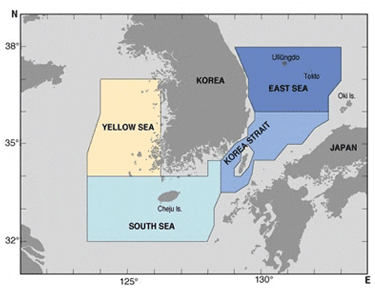The East Sea not only influences the weather of the neighboring nations with its warm and cold currents, but also affects fisheries in major ways.
In the past, fishermen cast their nets near the coast line along the Korea Sea, leaving the boundless bounty of fisheries of deep seas untouched. East sea fisheries were developed more recently in modern times, as vast improvements in equipment and powered vessels became available to deep sea fishermen. Today, Korea Sea has become one of the busiest fisheries in the world also becoming one of world’s 4 largest fisheries.
The east sea abounds with cold current fish, such as a squid, mackerel pike, sardine, as well as cold current fishes comprised of Pollack and codfish. Most of the warm current fishes migrate to North Korean coast from spring to summer and make a circular trip back southward in autumn. Among these fishes, a squid is the largest stock often caught in the East Sea. The squid migration moves southward toward Ullung Island and Mookho from June to September, which makes it most idea to fish for them around July to August time. The southerly migration of squid then moves southward to Pusan in mid-September.
The most ideal season for Mackerel is March to July, yielding a bountiful harvest. Sardines were once also caught in vast quantities in the past but the stock steadily went on a decline after war. However, research now indicates that the sardine stocks are on recovery and their populations on rebound.
Representative of warm current fish, Walleye Pollack has it base as Wonsan Bay as one of its main fishery. Pollack catch concurs with spawning season from November to December time, whereupon the hatchlings would pop up around Kangwon province. Codfish are mostly caught near the shores of South Kyungsang province.
The dragnet fishery of the East Sea is rather limited because of the narrow continental shelf. In that region, walleye pollack, codfish, sandfish, flounder, crab, shrimp, flatfish are caught. In addition, shellfish such as an abalone, white clams, agar brown seaweed and sea tangle also flourish there. Recent explorations in East Sea have yielded vast caches of developable energy in solid frozen methane gas clump form, awaiting extraction from deep seabed floor.









Recent Comments